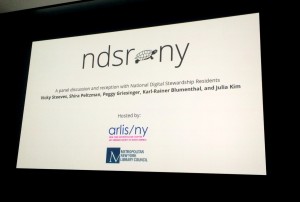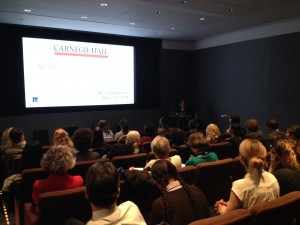Yesterday the entire cohort had the honor of presenting on our respective projects at an event co-sponsored by ARLIS/NY and Metro, so I thought I’d take this opportunity to recap the afternoon for those who weren’t able to make it.
The first resident to present was Vicky Steeves. Vicky began her presentation by offering an overview of the state of science data preservation in America, which was eye-opening to say the least. The context that she was able to provide about the dearth of preservation efforts around science data helped highlight both the importance of this task as well as some of the obstacles preventing its preservation. Vicky described her project and discussed the methodology she’s been using to interview AMNH staff, and wrapped up with an assessment of the kind of infrastructure she believes AMNH needs for their preservation efforts going forward.
Next up was yours truly. I began my talk by describing the kinds of digital content that I work with at Carnegie Hall, followed by the impetus for Carnegie Hall’s Digital Archives Project, of which my NDSR project is a key part. After offering a project update about where I am now and what remains to be done before the end of May, I wrapped up by offering a preview of some of the recommendations that I’m going to be including in my final deliverable, which is Digital Preservation and Sustainability document that will form the foundation of Carnegie Hall’s digital preservation policies. This part was really exciting for me because Gino Francesconi, the director of Carnegie Hall’s Archives and Rose Museum, was in attendance yesterday, and it was the first time that I had presented my recommendations to the Archives staff.
Up after me was Peggy, who began with an overview of MoMA’s new Digital Repository for Museum Collections (DRMC) followed by an explanation of where the process history for time-based media in MoMA’s collections fit into it. She outlined the process by which she arrived at the metadata schemas that she selected during the first phase of her project (spoiler alert: it’s an an alphabet soup of reVTMD, PREMIS, Mets and PBCore) and wrapped up by showing off some of the wireframes that she and her mentors recently received from Artefactual (MoMA’s vendor) detailing how the process history will be incorporated into the DRMC.
Next up was Karl, who began with an impressive explanation of how web archiving actually works. Karl gave an overview of NYARC’s web archiving process as well as an explanation of his project to improve the documentation process for web archiving quality assurance there.
Last but not least was Julia, who rather than provide an overview of the whole process of digital forensics at the NYU Libraries, opted instead to focus in on a case study—the Jeremy Blake papers. Julia began by explaining what Blake’s work is like and describing the techniques he used to make his art. Her presentation focused on explaining how digital forensics were employed with regard to the Blake papers, and why digital forensics were necessary in order to make this work accessible and fully understandable to anyone seeking to research his work. Julia also updated us on her progress with making emulated access available to researchers.
Listening to everyone present was a hugely rewarding experience because we’re all close enough to the end of our residencies that we were all able to offer previews of what our final deliverables would be. It was impressive to see how much progress we’ve made on our respective projects. These presentations made the first weeks and months of our residencies when we were still trying to wrap our minds around how we’d ever accomplish the tasks at hand feel like a distant memory. For me, they also drove home the realization that we’re much closer to the end than I have allowed myself to believe.




